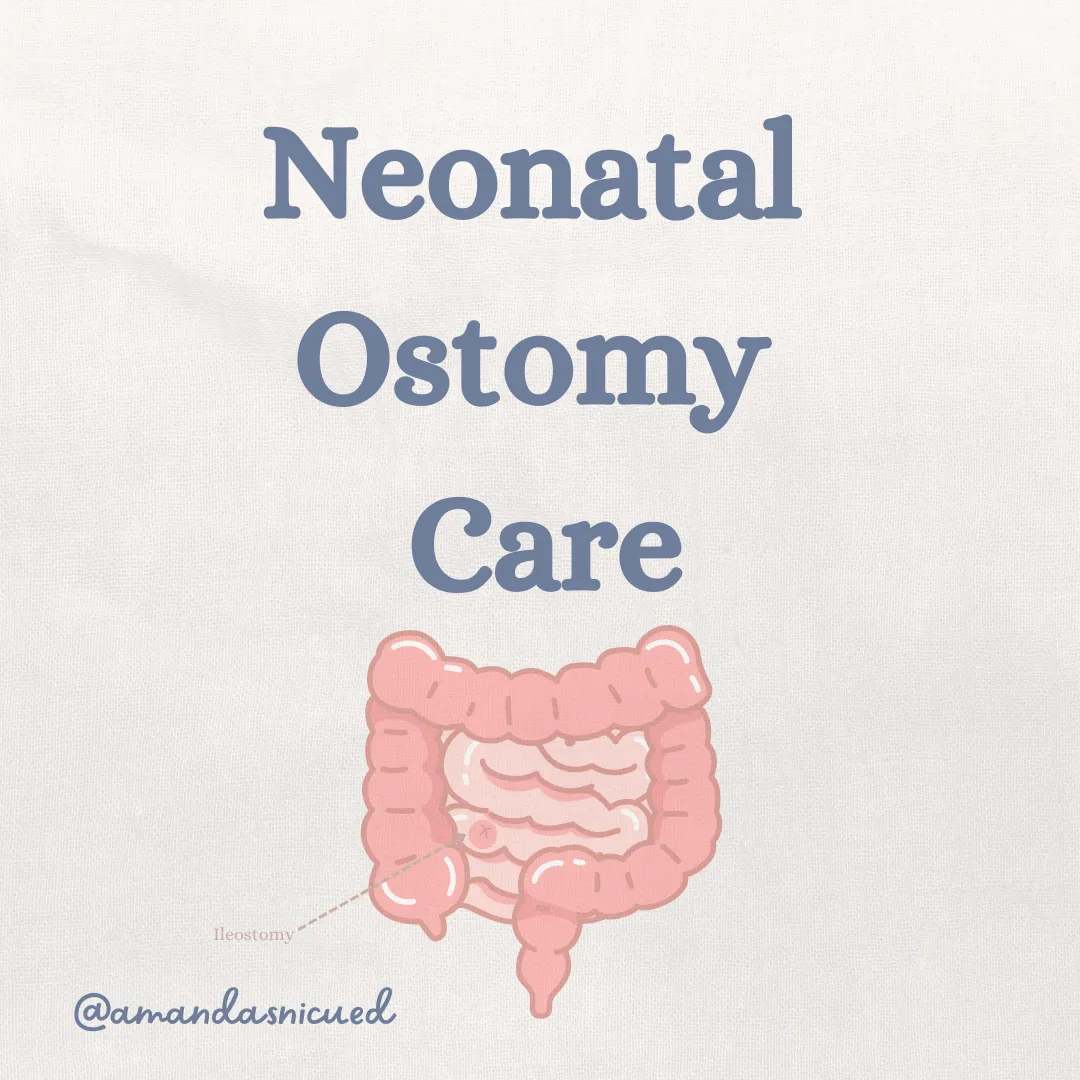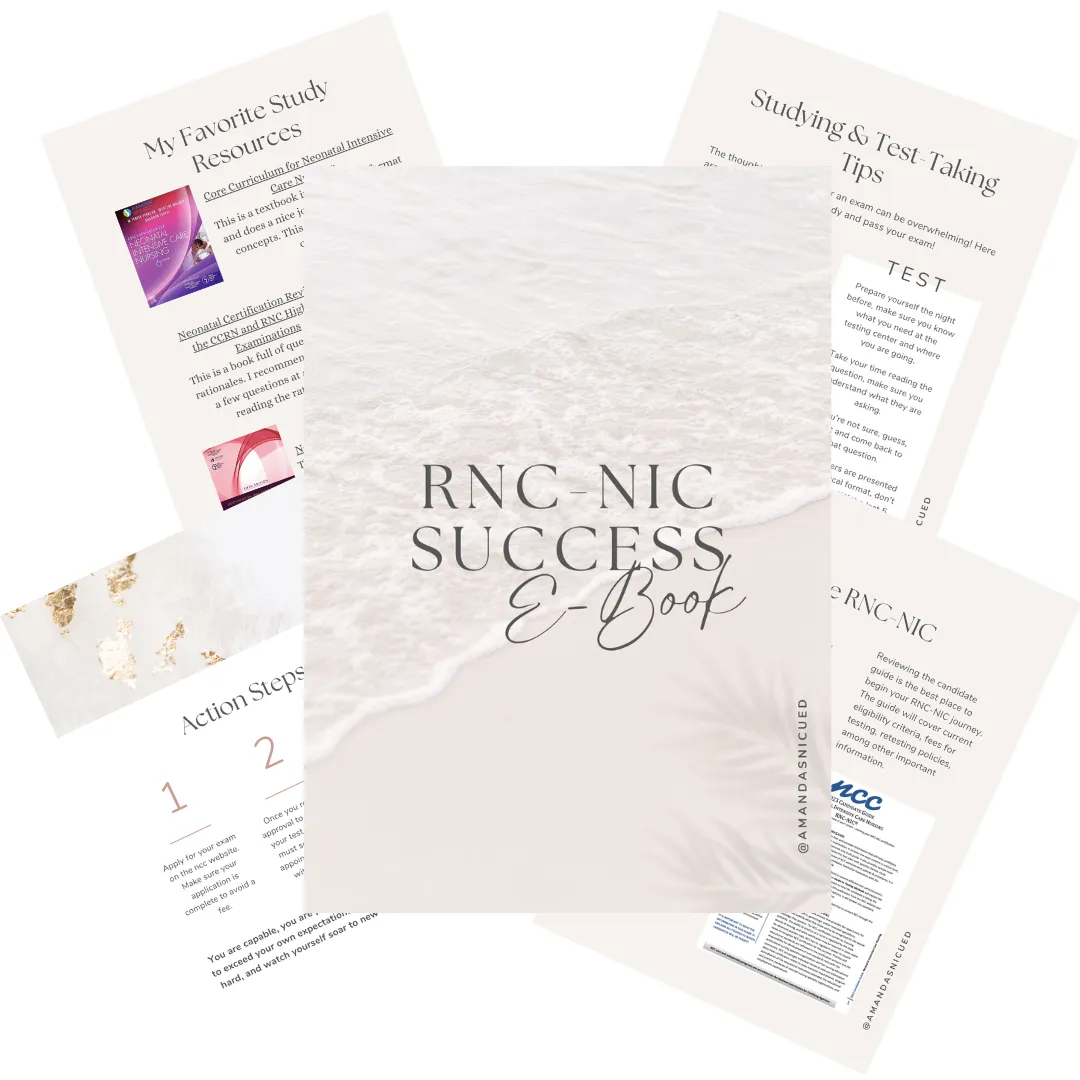
Welcome to Amanda's NICU Education




Hi! My name is Amanda. I'm a NICU nurse, Clinical Nurse Specialist, NICU Educator... basically your NICU BFF. If you want to talk NICU, I'm here for you! I love everything about NICU nursing and I'm eager to learn and share my knowledge with all my NICU friends.
I have been a NICU nurse since 2009 I am currently a Clinical Nurse Specialist in a Level IV NICU in Los Angeles.
I am passionate about educating the next generation of NICU nurses. I share my knowledge through platforms such as Instagram and Facebook and am excited to have you here on my website!
Click on the button below to sign up for my newsletter filled with NICU education and tips for all experience levels.

Not very many people love taking tests but as a self-acclaimed "forever student" who has taken (and passed) five different certification exams I am no longer afraid of tests! "Way to brag", you might be thinking but I want to help YOU pass your certification exam too!
Introducing Amanda's RNC-NIC Success digital course - your ultimate study companion!
Gain unlimited, on-demand access for life, ensuring you're primed to ace your certification exam.
I'm here to help you succeed and I can't wait for you to share with me that you PASSED the RNC-NIC EXAM!!!










Ostomy Care
Understanding Neonatal Ostomy Care
Caring for neonates with ostomies can be challenging, but with proper knowledge and skills, NICU nurses can ensure the best outcomes for these vulnerable patients. This newsletter will provide an overview of neonatal ostomy care, focusing on understanding stomas, supplies, techniques, and complications.
What is an Ostomy?
An ostomy is a surgically created opening (stoma) that allows stool or urine to exit the body when the natural passage is nonfunctional. In neonates, ostomies are often temporary measures to bypass damaged or underdeveloped parts of the digestive or urinary system. Common indications include congenital anomalies (e.g. Hirschsprung's Disease), necrotizing enterocolitis (NEC), and intestinal atresia.

Stock Image
Types of Stomas
Colostomy: Created in the colon to divert stool.
Ileostomy: Created in the ileum, often producing more liquid stool due to its location in the small intestine.
Jenunostomy: Created in the jejunum, output is usually very liquid and contains digestive enzymes, which can be highly irritating to the peri-stomal skin
Urostomy: A urostomy is created to divert urine when the bladder or urinary tract is nonfunctional.
Each type requires tailored care based on the output’s consistency and volume.

Unique Challenges in the Neonatal Population
Small Stoma Size: This makes handling and fitting appliances more difficult.
Fragile Skin: Neonatal skin is extremely delicate and prone to breakdown.
Frequent Stooling: Neonates often have frequent, liquid stools, increasing the risk of leakage and skin irritation.
Abdominal Contours: Neonates often have rounded abdomens, making it challenging to achieve a good seal.
Ostomy Supplies & Accessories
Ostomy Pouch: Collects stool. Pouches may be one-piece (integrated with the skin barrier) or two-piece (separate skin barrier and pouch).
Skin Barrier (Wafer): Adheres directly to the skin to protect peri-stomal skin from irritation and allows the pouch to adhere securely.
Adhesive Paste or Strips: Used to fill gaps and create a seal to prevent leaks.
Stoma Powder: Absorbs moisture and protects irritated skin.
Barrier Rings: Enhance the seal around the stoma.
Scissors: Trim pouches or barriers to fit the stoma size.
Adhesive remover: Used to prevent medical adhesive related skin injury when removing an appliance.
Skin prep: Protects the skin from adhesive and bodily fluids
Understanding how and when to use these accessories can significantly improve the time the appliance remains intact and overall patient comfort.
How to Change an Ostomy Appliance
Gather Supplies & Hand hygiene: Prepare all necessary items before starting and perform hand hygiene
Remove the Old Appliance: Start by gently lifting a corner of the barrier and using an adhesive remover wipe to separate the adhesive from the skin, working your way around the barrier. Using adhesive remover is important in preventing medical adhesive related skin injury (MARSI) in fragile newborn skin.
Clean the Stoma and Skin: Use warm water and a soft cloth; avoid soaps with residue.
Assess the Stoma and Skin: Check for redness, swelling, or skin breakdown.
Measure the stoma: The stoma can become swollen in the first few weeks after surgery. Measure every time to ensure an adequate fit.
Apply skin prep: to clean dry skin
Prep the new appliance: Cut the new wafer to size, leaving a small margin around the stoma to prevent constriction.
Use accessories if needed: Caulking agents like strip paste and barrier rings can help fill in gaps where there are uneven areas of skin (e.g. incision site or the umbilicus). These accessories will not act as a "glue" or increase adherence to the skin.
Apply the New Appliance: Ensure a snug fit around the stoma with minimal gaps to prevent leaks. Secure the pouch to the skin barrier.
Document Findings: Note any abnormalities or complications and update the care plan.
Common Complications
Peri-Stomal Skin Breakdown: Often caused by leakage. Prevention includes using properly fitted barriers and treating irritation promptly with stoma powder and skin prep.
Stoma Prolapse: The stoma extends further than normal. This may require surgical evaluation if severe.
Retraction: The stoma sinks below the skin level, increasing leakage risk. Using a convex barriers can help bring the stoma up.
Blockage: Signs include absence of output and swelling. Notify the healthcare provider immediately.
Stoma necrosis: Stoma's should be a "beefy red" if the stoma appears cyanotic, grey, or black notify the medical and surgical team immediately. This is a surgical emergency.

Thank you for your dedication to NICU nursing and for continuously improving your skills to care for our smallest patients. What are your best tips for providing stoma care?
Happy New Year!
Amanda
Missed my other newsletters? Click here to read them!
Let's Study Together! Join my Certification Course
Reference:
Kalish B. T. (2017). Management of Neonatal Hypotension. Neonatal network : NN, 36(1), 40–47. https://doi.org/10.1891/0730-0832.36.1.40
Noori, S. & Seri, I. (2024). Cardiovascular Compromise in the Newborn Infant in Avery’s Diseases of the Newborn. Elsevier
Rios, D., Vasquez, A., & McPherson, C. (2024). Neonatal Cardiovascular Drugs in Neonatology Questions and Controversies: Neonatal Hemodynamics. Elsevier
Barnes, J., Jnah, A., Dias, P. (2024) Hypotension and Shock in Fetal and Neonatal Pharmacology for the Advanced Practice Nurse. Springer Publishing Company

December 2023 Certification Review Webinar
NICU Certification Review



Ready to kickstart your journey to becoming a certified NICU nurse?
Look no further!
Grab my FREE E-Book packed with essential study and test-taking strategies for the RNC-NIC.
In the E-Book I give you the resources you need including the link to access the candidate guide, several types of books to study from, some of my favorite strategies, an outline of the content you should review, and a blank calendar for you to make your study plan!
Frequently Asked Questions About the RNC-NIC exam

What is the RNC-NIC?
The RNC-NIC is a competency-based exam that tests the specialty knowledge of nurses in the United States & Canada who care for critically ill newborns and their families.
The RNC-NICU is a nationally recognized certification that recognizes the registered nurse for their specialty knowledge and skill.

Who can take the RNC-NIC exam?
Nurses can take this exam after a minimum of two years experience in the NICU caring for critically ill newborns and their families.

Which books should I use?
I'm glad you asked! There are many excellent books to help you prepare for the RNC-NIC, I gathered ande describe each of them for you in my FREE e-book.
Is there a course to help me study?
Yes! Many hospitals host their own certification course and there are a few online courses. See my RNC-NIC test taking tips E Book for more information
What happens if I don't pass the exam?
If you don't pass the exam on your first try you can try again after 90 days. You will have to reapply after 90 days and pay a retest fee. There is no limit to the number of times you can take the exam (however a candidate can only sit for the exam twice per year).

Can I make more money if I take the RNC-NIC exam and get certified?
Yes! Many hospitals provide a raise or a bonus for nurses with specialty certifications. Hospitals also typically hire at a higher base salary when nurses have a certification.

Find me @amandasnicued on these channels or Email me
hey nurses don't miss out
© Copyright 2024. AmandasNICUEd. All rights reserved. | Terms & Conditions | Privacy Policy Contact: [email protected]

